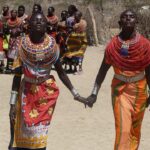Planning a wedding can be an exciting yet overwhelming experience, especially when understanding the customs and traditions of different cultures.
Uganda weddings are full of vibrant colors, rich culture, and centuries-old traditions that have been passed down from generation to generation.
From traditional attire to reception rituals and superstitions – let’s explore some fascinating Uganda wedding traditions.
It’s time for us all to dive deep into the world of Ugandan nuptials – so strap in as we take you on a journey through this incredible culture.
Uganda Wedding Traditions
Ugandan Wedding Traditions
1. The Proposal and Engagement
In Uganda, traditional marriage proposals involve the groom’s family visiting the bride’s family with gifts, such as livestock or items of value.
Depending on the customs of the particular tribe and family, a spokesman for the groom may present a formal speech to ask for permission to court the bride.
The bride’s parents may then ask what kind of dowry has been offered in exchange for their daughter. If all parties are agreed, the date will be set for formal engagement ceremonies and wedding celebrations.
Bachelorette parties are beginning to be more popular in Uganda, although they are not a traditional custom.
In some cases, brides or grooms might arrange a small gathering with their friends and family to celebrate the soon-to-be-married chapter of their life.
These gatherings usually involve activities such as dancing, eating, and drinking together.
2. Traditional Attire
Ugandan weddings typically involve traditional attire for the bride, groom, bridal party, and guests.
For the bride, this usually includes a colorful dress or skirt and blouse with a head wrap.
The outfit is often made of bright colors such as yellow, green or blue to represent joy and happiness.
Ugandan brides typically wear lots of traditional accessories to complement their wedding attire.
These accessories are usually made from materials like beads and cowrie shells.
Commonly seen items include a headdress, bracelets, anklets, waist beads and beaded necklaces.
The bride may also wrap colorful cloths around her waist as a symbol of blessings from the elders in her family.
The colors and styles chosen by the bride reflect her individual style and personality.
The groom wears a shirt and trousers with a matching head wrap.
This outfit is often in darker shades, such as black or navy blue, to signify strength and stability.
For the bridal party, bridesmaids often wear dresses in similar colors to the bride’s outfit, while groomsmen wear shirts and trousers that match the groom’s outfit.
Guests typically also wear bright colors such as yellow, green, or blue, which adds to the overall festive atmosphere of the wedding day.
When selecting traditional Ugandan attire for your wedding day it is important to remember that each color has its own meaning, so be sure you choose wisely.
Yellow symbolizes joy, while green represents fertility; both are popular choices among couples getting married in Uganda.
Blue signifies peace and red stands for passion – perfect if you want your special day to be full of love.
Finally, black is associated with strength, which can help balance all these other emotions on your big day.
Ceremony Traditions
Ugandan wedding ceremonies are full of meaningful rituals that honor the couple’s union.
The processional and recessional music is usually traditional Ugandan songs, played to welcome the bride and groom into the ceremony.
This is followed by an exchange of vows and rings, symbolizing their commitment to each other.
After this, elders bless the marriage union with words of wisdom for a long-lasting relationship.
Lastly, unity rituals such as tying hands or jumping over a broomstick signify two people becoming one family unit.
These customs bring joy to both families involved in the celebration and create memories that will last forever.
3. Venue
Ugandan weddings generally occur in a traditional setting, such as the bride’s family home or a church.
Depending on the region, the ceremony might also take place at a public venue, such as a community center or an outdoor space.
Commonly seen items in these venues include colorful decorations, traditional music and dance performances, and ceremonial attire for both the bride and groom.
Special food and drinks are usually served to honor the newlyweds.
4. Processional and Recessional
The processional music typically consists of drums playing while everyone stands up in anticipation of the bride and groom’s arrival.
As they enter, more instruments create a festive atmosphere filled with excitement from all those present at the ceremony.
Then when it’s time for them to leave after being pronounced husband and wife, everyone cheers as they walk out accompanied by joyful music signaling their new life together has begun.
5. Exchange Of Vows And Rings
This part marks an important milestone in any marriage where couples make promises to love each other through thick or thin no matter what comes their way throughout life’s journey together as partners.
They then exchange rings representing eternity; never-ending love between them until death do them part.
6. Blessing Of The Marriage Union
In many Ugandan weddings, some elders offer blessings upon this special occasion either through prayer or wise words meant to guide newlyweds on how best they can handle any situation that may arise during their married life ahead.
It is also believed these blessings will bring good luck into their home, ensuring prosperity for years down the line.
7. Unity Rituals
One popular tradition among Ugandans involves tying hands together using colorful fabric known as “Kwanjula” cloth which symbolizes strength in unity even when faced with difficult times ahead.
Now they have each other’s support like no one else can provide.
Another ritual includes jumping over a broomstick, signifying sweeping away all bad omens, so only positive energy remains within their home from here on out.
Reception Traditions
After the ceremony comes the reception, where newlyweds are introduced to their guests for the first time as husband and wife.
This is a special moment that should be celebrated with joy and enthusiasm.
The couple’s introduction can be done in various ways, from having an MC announce them to music playing as they enter.
It’s up to you how you want your entrance into this new stage of life together to be remembered.
8. First Dance
The next tradition is usually a First Dance as a Couple. This is another opportunity for couples to express their love for each other in front of all their family and friends.
You can choose any song with a special meaning or just one that makes you feel like dancing.
Whatever song you pick will make it even more memorable when shared with everyone at your wedding reception.
9. Cake Cutting
The cake-cutting ceremony follows after the first dance, which marks yet another milestone in married life: sharing something sweet together.
As part of this ritual, couples cut into their cake while holding hands – symbolizing how they will always support each other through thick and thin going forward.
After cutting into it, they feed each other small pieces before offering slices out to all their guests – creating an intimate moment between them while also involving everyone else.
10. Food and Drink
When it comes to food, a typical Ugandan wedding feast usually consists of dishes like roasted chicken, beef stew, and plenty of local produce such as fruits, vegetables, and legumes.
Spicy sauces and stews are often served alongside rice.
Traditional drinks such as sorghum beer and palm wine are also commonly served at weddings.
11. Music
Music is an essential part of Ugandan weddings.
Traditional songs, called Runyege, are performed at the ceremony to honor the couple and their families.
Singers or dancers may also be hired for entertainment throughout the reception.
Modern music is often incorporated into Ugandan weddings as well. Popular selections include Afrobeats, dancehall reggae, and hip-hop from artists like Big Tril and Kalifah Aganaga.
DJs often spin up a mix of traditional and modern beats to get guests on their feet and keep them dancing until late in the evening.
12. Other traditional rituals:
Bouquet Toss and Garter Removal (or vice versa). Both involve throwing items out into the crowd so single ladies (for bouquets) or unmarried men (for garters) can catch them, bringing luck upon whoever catches either item according to superstition.
These activities add fun elements during receptions, but if either partner doesn’t desire either, then there is no need for them; what matters most is celebrating marriage on your terms without pressure from anyone else around you.
Cultural Customs and Superstitions
In Uganda, pre-wedding celebrations involve traditional dances performed by family members to bless the couple’s union.
These dances are usually accompanied by singing and drumming to express joy for the upcoming marriage.
Gifts such as money or jewelry may also be exchanged between families during these festivities.
After the wedding ceremony, there is typically a post-wedding celebration involving feasting traditional dishes like matoke (mashed plantains) accompanied by drumming and dancing.
This is done to celebrate the newlywed couple’s union and provide them with blessings for their future.
The bride and groom may also exchange symbolic gifts such as jewelry or money during this time.
13. Gifts
Symbolic gifts are often exchanged between families at pre-wedding and post-wedding celebrations in Uganda.
In addition, Ugandan couples may receive various gifts from their family and friends to celebrate their marriage.
Traditional presents are given on the wedding day, often consisting of food items such as fruits, vegetables, and livestock, as well as utensils and clothes for the couple’s new home.
More modern gifts may include electronics like televisions or computers, jewelry for the bride, or money.
It is common for family members to give the couple kitchen supplies such as plates, stainless steel pots, and cooking utensils so they can begin their life together with everything they need.
14. Ugandan Wedding Superstitions
Ugandan wedding superstitions are an important part of the country’s culture. Commonly seen traditions include:
- The bride and groom should not eat together before the wedding, which is believed to bring bad luck.
- It’s considered unlucky to throw rice, coins, or other items at the couple; instead, guests may wave garlands over them for good luck.
- During the wedding, the bride and groom should not wear black; it’s believed this color attracts evil spirits.
- The bride must not step on her husband’s feet during their first dance; doing so is thought to bring bad luck to their marriage.
- Couples should avoid getting married on Tuesdays or Saturdays since those days are considered unlucky when it comes to weddings in Ugandan culture.
Conclusion
Uganda wedding traditions are a unique and beautiful way to celebrate the union of two people.
From traditional attire, ceremony rituals, reception customs, and cultural superstitions, there is something for everyone to enjoy.
Whether you’re looking for an intimate gathering or a large celebration with all your family and friends, these Uganda wedding traditions will make your special day one that you won’t soon forget.




